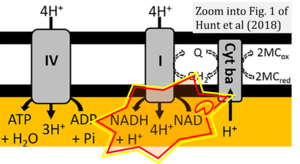Hunt 2018 PLoS Comput Biol
| Hunt KA, Jennings RM, Inskeep WP, Carlson RP (2018) Multiscale analysis of autotroph-heterotroph interactions in a high-temperature microbial community. PLoS Comput Biol 14:e1006431. https://doi.org/10.1371/journal.pcbi.1006431 |
Hunt KA, Jennings RM, Inskeep WP, Carlson RP (2018) PLoS Comput Biol
Abstract: Interactions among microbial community members can lead to emergent properties, such as enhanced productivity, stability, and robustness. Iron-oxide mats in acidic (pH 2-4), high-temperature (> 65 °C) springs of Yellowstone National Park contain relatively simple microbial communities and are well-characterized geochemically. Consequently, these communities are excellent model systems for studying the metabolic activity of individual populations and key microbial interactions. The primary goals of the current study were to integrate data collected in situ with in silico calculations across process-scales encompassing enzymatic activity, cellular metabolism, community interactions, and ecosystem biogeochemistry, as well as to predict and quantify the functional limits of autotroph-heterotroph interactions. Metagenomic and transcriptomic data were used to reconstruct carbon and energy metabolisms of an important autotroph (Metallosphaera yellowstonensis) and heterotroph (Geoarchaeum sp. OSPB) from the studied Fe(III)-oxide mat communities. Standard and hybrid elementary flux mode and flux balance analyses of metabolic models predicted cellular- and community-level metabolic acclimations to simulated environmental stresses, respectively. In situ geochemical analyses, including oxygen depth-profiles, Fe(III)-oxide deposition rates, stable carbon isotopes and mat biomass concentrations, were combined with cellular models to explore autotroph-heterotroph interactions important to community structure-function. Integration of metabolic modeling with in situ measurements, including the relative population abundance of autotrophs to heterotrophs, demonstrated that Fe(III)-oxide mat communities operate at their maximum total community growth rate (i.e. sum of autotroph and heterotroph growth rates), as opposed to net community growth rate (i.e. total community growth rate subtracting autotroph consumed by heterotroph), as predicted from the maximum power principle. Integration of multiscale data with ecological theory provides a basis for predicting autotroph-heterotroph interactions and community-level cellular organization.
• Bioblast editor: Gnaiger E
Hydrogen ion ambiguities in the electron transfer system
Communicated by Gnaiger E (2023-10-08) last update 2023-11-10
- Electron (e-) transfer linked to hydrogen ion (hydron; H+) transfer is a fundamental concept in the field of bioenergetics, critical for understanding redox-coupled energy transformations.
- However, the current literature contains inconsistencies regarding H+ formation on the negative side of bioenergetic membranes, such as the matrix side of the mitochondrial inner membrane, when NADH is oxidized during oxidative phosphorylation (OXPHOS). Ambiguities arise when examining the oxidation of NADH by respiratory Complex I or succinate by Complex II.
- Oxidation of NADH or succinate involves a two-electron transfer of 2{H++e-} to FMN or FAD, respectively. Figures indicating a single electron e- transferred from NADH or succinate lack accuracy.
- The oxidized NAD+ is distinguished from NAD indicating nicotinamide adenine dinucleotide independent of oxidation state.
- NADH + H+ → NAD+ +2{H++e-} is the oxidation half-reaction in this H+-linked electron transfer represented as 2{H++e-} (Gnaiger 2023). Putative H+ formation shown as NADH → NAD+ + H+ conflicts with chemiosmotic coupling stoichiometries between H+ translocation across the coupling membrane and electron transfer to oxygen. Ensuring clarity in this complex field is imperative to tackle the apparent ambiguity crisis and prevent confusion, particularly in light of the increasing number of interdisciplinary publications on bioenergetics concerning diagnostic and clinical applications of OXPHOS analysis.
- Fig. 1 of Hunt et al (2018): NADH is shown as the product of the reaction catalyzed by CI in respiration.



